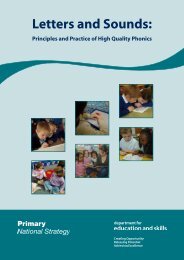Research Brief - Department for Education
Research Brief - Department for Education
Research Brief - Department for Education
You also want an ePaper? Increase the reach of your titles
YUMPU automatically turns print PDFs into web optimized ePapers that Google loves.
ehaviour (ES=0.27) and ‘Self-regulation’<br />
ES=0.17). High levels of classroom<br />
Disorganisation predicted poorer progress in both<br />
Reading (ES=0.21) and Mathematics (ES=0.34)<br />
and increased ‘Hyperactivity’ (ES=0.37).<br />
Teachers’ reports of their school context and<br />
processes (particularly the five factors concerning<br />
Use of homework and school standards, Pupils’<br />
agency and voice, Anti-academic ethos, School<br />
communication with parents, and Parental support<br />
of their child’s learning) were related to better<br />
progress in Mathematics and social outcomes (ES<br />
from 0.27 to 0.38) at age 10. In schools where<br />
teachers reported active School communication<br />
with parents, pupils made better academic<br />
progress in Reading (ES=0.38) and Mathematics<br />
(ES=0.34), and showed better ‘Self-regulation’<br />
(ES=0.27). In addition, where teachers reported<br />
strong Parental support <strong>for</strong> their child’s learning,<br />
pupils made better progress in Reading (ES=0.28)<br />
and ‘Pro-social’ behaviour (ES=0.38).<br />
The Ofsted inspection measure of overall School<br />
effectiveness was a moderately strong predictor of<br />
pupil progress in Mathematics (ES=0.41) and<br />
‘Self-regulation’ (ES=0.39) whilst the judgement on<br />
the Quality of school leadership showed a positive<br />
relationship with Mathematics progress (ES=0.32).<br />
Ofsted’s judgement of a school’s Improvement<br />
since last inspection was a significant predictor of<br />
EPPE 3-11 pupils’ Mathematics progress<br />
(ES=0.35), and development in ‘Self-regulation’<br />
(ES=0.49), ‘Pro-social’ (ES=0.43) and ‘Anti-social’<br />
behaviour (ES=0.31).<br />
5 How pre-school and primary school interact to<br />
affect pupils’ learning and development<br />
EPPE 3-11 is the first study to investigate the<br />
combined effects of pre-school and primary school<br />
on a wide range of child outcomes. The<br />
combination of attending a higher quality preschool<br />
and then moving on to an academically<br />
effective primary school had additional benefits <strong>for</strong><br />
pupils’ cognitive outcomes at age 11, especially so<br />
in Mathematics (ES=0.67). High quality preschool<br />
appears to provide some ‘protection’<br />
against attending an ineffective primary school<br />
compared to pupils who had not attended preschool:<br />
weakly <strong>for</strong> English (ES=0.12), and much<br />
more strongly <strong>for</strong> Mathematics (ES=0.61); or those<br />
who had attended pre-schools of lower quality.<br />
The reverse was also true: pupils who attended a<br />
primary school of high academic effectiveness<br />
managed to do well in Mathematics in Key Stage 2<br />
even if they had not attended a pre-school<br />
(ES=0.43) or if their pre-school was of low quality<br />
(ES=0.45).<br />
6 Influences are different <strong>for</strong> English, Mathematics<br />
and social/behavioural development<br />
By Year 6 the influences on English were<br />
somewhat different from Mathematics in certain<br />
aspects. For English, child, family and home<br />
background mattered relatively more than <strong>for</strong><br />
Mathematics, where the effect of educational<br />
influences was stronger. For English the effects of<br />
mothers’ highest qualification (ES 0.76) and the<br />
Early years HLE (ES=0.69) were over twice as<br />
great as those of pre-school or primary school.<br />
For Mathematics, mothers’ highest qualification<br />
(degree or above versus none) was again the<br />
strongest predictor (ES=0.71), but with pre-school<br />
(ES=0.40) and primary school academic<br />
effectiveness (ES=0.38) being relatively more<br />
influential than they were <strong>for</strong> English (ES=0.25 and<br />
ES=0.24 respectively) and comparable to the<br />
effect size of Early years HLE (ES=0.42).<br />
Patterns of influence are also different <strong>for</strong><br />
social/behavioural development. In Year 6,<br />
background characteristics were found to be better<br />
predictors of ‘Self-regulation’ than <strong>for</strong> other<br />
social/behavioural outcomes. In addition, gender<br />
effects were particularly strong <strong>for</strong> ‘Pro-social’<br />
behaviour (ES=0.71) and ‘Hyperactivity’ (ES=-<br />
0.71) outcomes, having around twice as large an<br />
effect as pre-school quality (ES=0.28) and<br />
effectiveness (ES=0.38). Mothers’ highest<br />
qualification level was also an important predictor<br />
and had the strongest effects <strong>for</strong> ‘Self-regulation’<br />
(ES=0.55) and ‘Hyperactivity’ (ES=-0.53)<br />
outcomes. Thus the patterns of influence vary to<br />
some extent <strong>for</strong> different outcomes, as well as <strong>for</strong><br />
different groups of pupils. Only a large scale and<br />
longitudinal study could reveal such subtle<br />
differences, along with the interacting effects of<br />
pre-school and primary education.<br />
7 Pupils’ self-perceptions: what influences them<br />
and their effects on future development?<br />
Influential factors <strong>for</strong> pupils’ self-perceptions were<br />
different <strong>for</strong> each self-perception measure.<br />
Gender was the strongest predictor of<br />
‘Behavioural self-image’ (ES=0.53), whereas <strong>for</strong><br />
‘Academic self-image’ the strongest predictors<br />
were fathers’ highest qualification level (ES=0.27)<br />
and Early years HLE (ES=0.24). ‘Enjoyment of<br />
school’ was somewhat higher <strong>for</strong> pupils who were<br />
eligible <strong>for</strong> FSM (ES=0.26) and <strong>for</strong> those who had<br />
previously attended high quality pre-school versus<br />
low quality (ES=0.18).<br />
Pupils’ self-perception factors were differentially<br />
associated with their other educational outcomes.<br />
Pupils’ ‘Academic self-image’ was the strongest<br />
predictor of progress in Reading (ES=0.38),<br />
Mathematics (ES=0.51) and ‘Self-regulation’
















